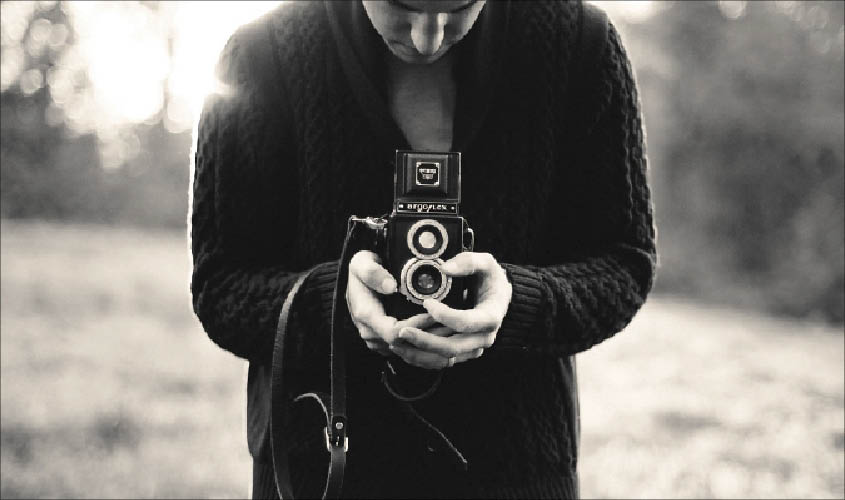The camera’s vision, unmediated by consciousness or an uncertain memory, allows the past to speak for itself, inviting the beholder to step in and find her own meaning. In this essay, Veeksha Vagmita explores the many meanings, personal and public, of photography.
The tokens of togetherness that I find in my old family albums hark back to a time when photos were clicked only occasionally to mark a moment. They froze moments that stood out and were, therefore, memorable. This carefully selected reality is a kind of wish-fulfilment not afforded by the banal shots that my phone is jammed with. The photo albums were not just dusty records of the past. Their reassuring tangibility brought the past tantalisingly close even if the crumbling edges bespoke the ravages of time. The once-cherished, but now increasingly rare, task of gazing wondrously at pictures (without the distraction of sharing, posting, liking, cropping, multiplying them) made them both mysterious and revelatory.
The camera’s vision, unmediated by consciousness or an uncertain memory, allows the past to speak for itself, inviting the beholder to step in and find her own meaning. Andre Bazin captures this dimension of photography while comparing it to painting and its aesthetic: “Only the impassive lens, stripping its object of all [the] ways of seeing it … that spiritual dust and grime with which my eyes have covered it, is able to present it in all its virginal purity”.
Life’s memorable moments must have lost some of their seductive transience once they could be frozen and filed away. Eventually photographs themselves became objects of contemplation; in contemporary lingo, they became the “real thing”, giving both legitimacy and lustre to reality. That we’ve “learn[ed] to see ourselves photographically” is an observation Susan Sontag made even before the digital onslaught of images.
With so much of photographic trail left behind every day, my memories may have started to lose their distinctive edge. Instead of images distilled by my consciousness, I have slideshows compiled by my cellphone. Cherished snaps are juxtaposed with stray shots and time-fillers. Nostalgia is digitally induced.
To me, these throwbacks only throw into relief the garbled nature of my memories or at least their photographic equivalent. The pictures on my phone embody the randomness of forgetful moments, which are interspersed incongruously with the occasional prized recollections. My photographs are so scattered among drives, shared links, WhatsApp chats, mobile galleries, among other forgotten places, that the task of assembling and arranging them seems frightfully tedious. If I do manage to pry them out of their hiding places, how would I secure them from the fickleness of technology and the vulnerability of online data? I might just fall back on photo albums and convert the ghostly traces on my devices into glossy, feel-good prints.
After all, the narrative passed down to me through photo albums was a result of thoughtful documentation, necessitated by technological limitations, including longer exposure and processing time. The photos have a materiality and selectiveness that gives them the solidity of recorded history, letting a narrative emerge on its own. While this is as much of a projection, a kind of fiction, as any personal history, it structures the imagination by offering a coherent picture of the past. The snatches of life stored on my phone, however, seem like a stream of floating images unsure of themselves, likely to be erased as inconsequentially as they came into being. This fluidity may be symptomatic of our liquid modernity, where “patterns and configurations are no longer ‘given’, let alone [be] self-evident”, leaving individuals without “stable orientation points”, as Zygmunt Bauman explains.
My family archive follows a pattern that was common before the age of floating images. The attempt
The neat archives bequeathed to me offer a highly curated version of the past, a version that not just “contributes to a living memory” (John Berger) but also replaces it (Sontag). Certain moments are favoured over others, moments which may otherwise have been given a proportionate weight through the workings of memory. Berger describes how “[t]he camera saves a set of appearances from the otherwise inevitable supersession of further appearances”. Also, the priority accorded to these specific moments is guided by present whim or choice (to photograph them) and not by hindsight or reflection. Such commemoration can over-determine and whitewash history. My varied catalogue, on the other hand, captures life in all its unevenness. Symmetry, after all, is imposed on, and not intrinsic to, life.
The whimsical shots and selfies of today, though they defy symmetry and such obvious posing, can sometimes give a feel of spontaneity to what is staged. They tend to make much of random moments. This can have its own upsides. The sheer abundance of mementos, spilling from mobile photo galleries, bestows significance upon ordinary moments. Such minor narratives seem to supplement or even supplant our grander life narratives in a way that is truly postmodern.
Meaning admittedly is not built into pictures (even those part of our personal archives); it requires an understanding of context. It can also be an exercise in interpretation. Our internal reality frames, often colours, our perception of the past. We mentally recontextualise our pictures. Out of the many shades of feeling communicated by them, the ones that blend easily with the present gain primacy. This is most evident in the case of ruptures. When life itself lacks a continuity of narrative, its mementos can be haunting. They tell a story at odds with our selective memory.
With the “burden of pattern-weaving” falling squarely on the individual in this “privatised version of modernity” (Bauman), interpreting the past may not simply be a question of disposition or preference. New paradigms would have to make sense of a life in flux, and its fitful traces. My digital repertoire could be the “photo album” I browse when I’m old enough to look back at my life. It may not be something to show off, just something to return to.

